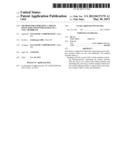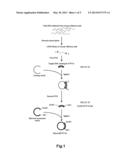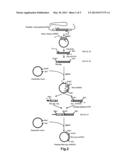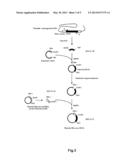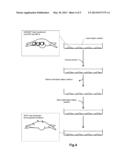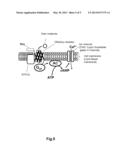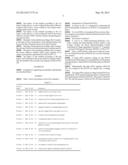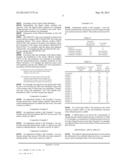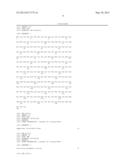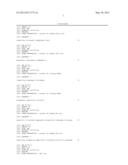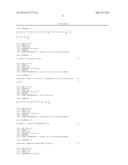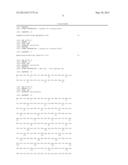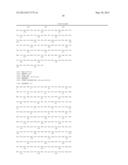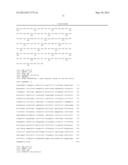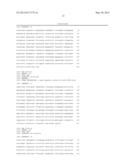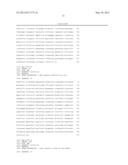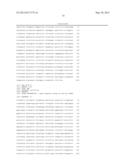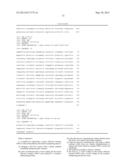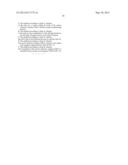Patent application title: METHOD FOR EXPRESSING A MOUSE OLFACTORY RECEPTOR OLFR15 ON A CELL MEMBRANE
Inventors:
Panasonic Corporation (Osaka, JP)
Yoshitsugu Uriu (Nara, JP)
Assignees:
PANASONIC CORPORATION
IPC8 Class: AC12N5071FI
USPC Class:
435455
Class name: Chemistry: molecular biology and microbiology process of mutation, cell fusion, or genetic modification introduction of a polynucleotide molecule into or rearrangement of nucleic acid within an animal cell
Publication date: 2013-05-30
Patent application number: 20130137179
Abstract:
Provided is a method for effectively expressing mouse olfactory receptor
Olfr15 on the cell membrane. The method includes steps of: bringing a
cell into contact with a culture medium containing chlorpromazine;
separating the culture medium from the cell so as to remove the culture
medium; and incubating the cell using a culture medium which does not
contain chlorpromazine to express the mouse olfactory receptor Olfr15 on
the cell membrane.Claims:
1. A method for expressing a mouse olfactory receptor Olfr15 on the cell
membrane, the method comprising steps of: (a) bringing a cell into
contact with a culture medium containing chlorpromazine; wherein the cell
is transfected with a vector coding for the mouse olfactory receptor
Olfr15 and coding for a receptor-transporting protein; (b) after the step
(a), separating the culture medium from the cell so as to remove the
culture medium; (c) after the step (b), incubating the cell using a
culture medium which does not contain chlorpromazine to express the mouse
olfactory receptor Olfr15 on the cell membrane.
2. The method according to claim 1, wherein in the step (a), a vector coding for the mouse olfactory receptor Olfr15 and a vector coding for the receptor-transporting protein are used.
3. The method according to claim 1, wherein in the step (a), a vector coding for both of the mouse olfactory receptor Olfr15 and the receptor-transporting protein.
4. The method according to claim 1, wherein in the step (a), the concentration of the chlorpromazine is not less than 10 μg/ml and not more than 25 μg/ml.
5. The method according to claim 1, wherein the cell is left at rest between the step (a) and the step (b).
6. The method according to claim 1, wherein the mouse olfactory receptor Olfr15 consists of an amino acid sequence represented by SEQ ID NO: 19.
7. The method according to claim 6, wherein the N-terminal of the mouse olfactory receptor Olfr15 is modified with an amino acid sequence SEQ ID NO: 18.
Description:
CROSS-REFERENCE TO RELATED APPLICATIONS
[0001] This is a continuation application of International Application No. PCT/JP2012/001784, with an international filing date of Mar. 14, 2012, which claims priority of Japanese Patent Application No. 2011-234874, filed on Oct. 26, 2011, the entire contents of each of which are incorporated herein by reference.
BACKGROUND OF THE INVENTION
Technical Field
[0002] The technical field relates to a method for expressing a mouse olfactory receptor Olfr15 on a cell membrane.
[0003] An olfactory receptor is a trimeric G protein-coupled receptor (hereinafter, referred to as "GPCR"). For example, the olfactory receptor is one kind of trimeric G protein-coupled seven-transmembrane receptors.
[0004] FIG. 5 shows a mechanism in which an odor molecule stimulus to a cell membrane is converted into an electrical signal.
[0005] The olfactory receptor is a membrane protein which is expressed on the cell membrane. The cell membrane is mainly composed of a lipid bilayer membrane. The lipid bilayer membrane has a two layer structure, each consisting of phospholipid molecules lined with a high density. This lipid bilayer membrane is schematically shown in the center of FIG. 5. In FIG. 5, the outside of the cell is above the upper part of the lipid bilayer membrane and the inside of the cell is below the lower part of the lipid bilayer membrane. The trimeric G protein is placed in the vicinity of the olfactory receptor.
[0006] The trimeric G protein is a heterotrimer composed of an alpha subunit (Gαolf), a beta-subunit (Gβ), and a gamma subunit (Gγ). The cell contains adenylate cyclase. In FIG. 5, the adenylate cyclase is referred to as "AC". The adenylate cyclase is a transmembrane-type protein. A protein RTP1S (SEQ ID NO: 01, Gen Bank Accession No: EU070411) assists the olfactory receptors to be expressed in the cell membrane, but is not directly associated with the mechanism shown in FIG. 5.
[0007] Next, the mechanism is described in further detail. The odor molecule binds to the olfactory receptor. The binding separates the trimeric G protein into the alpha subunit (Gαolf) and a beta--gamma complex. The beta-gamma complex consists of the subunit Gβ and the subunit Gγ. The separated Gαolf activates the adenylate cyclase (AC). The activated adenylate cyclase (AC) converts adenosine triphosphate (ATP) into cyclic adenosine monophosphate (cAMP).
[0008] The cyclic adenosine monophosphate (cAMP) activates an ion channel, for example, a cyclic nucleotide gated ion channel (CNG). The activation allows an ion to be transported from the inside of the cell to the outside of the cell, or from the outside of the cell to the inside of the cell. The degree of the transport of the ion can be measured as an electric signal.
[0009] The mouse olfactory receptors include various olfactory receptors depending on an odor molecule to be recognized. An example of the mouse olfactory receptor is a mouse eugenol olfactory receptor mOREG, a mouse olfactory receptor Olfr168, a mouse olfactory receptor Olfr15, or a mouse olfactory receptor Olfr609.
[0010] The mouse eugenol olfactory receptor mOREG recognizes eugenol. In other words, the mouse eugenol olfactory receptor mOREG is stimulated by eugenol. Eugenol serves as an odor molecule with regard to the mouse eugenol olfactory receptor mOREG. The mouse eugenol olfactory receptor mOREG is referred to as a mouse olfactory receptor Olfr73.
[0011] The mouse olfactory receptor Olfr168 recognizes 2-pentanone. In other words, the mouse olfactory receptor Olfr168 is stimulated by 2-pentanone. 2-pentanone serves as an odor molecule with regard to the mouse olfactory receptor Olfr168.
[0012] The mouse olfactory receptor Olfr15 recognizes cyclohexanone. In other words, the mouse olfactory receptor Olfr15 is stimulated by cyclohexanone. Cyclohexanone serves as an odor molecule with regard to the mouse olfactory receptor Olfr15.
[0013] The mouse olfactory receptor Olfr609 recognizes vanillic acid. In other words, the mouse olfactory receptor Olfr609 is stimulated by vanillic acid. The vanillic acid serves as an odor molecule with regard to the mouse olfactory receptor Olfr609.
[0014] Non Patent Literature 1 discloses a method for expressing an odorant receptor on a cell membrane by using a receptor-transporting protein (hereinafter, referred to as "RTP") such as RTP1S.
[0015] For example, cells are transfected with a vector containing a gene sequence coding for an olfactory receptor and with a vector containing a gene sequence coding for the RTP. These cells are incubated to express the olfactory receptor on the cell membrane.
CITATION LIST
[0016] Non Patent Literature 1
[0017] Saito, H., M. Kubota, et al. (2004). "RTP family members induce functional expression of mammalian odorant receptors." Cell 119(5): 679-691.
SUMMARY
[0018] As demonstrated in the Comparative Example 1, which is described later, even when cells were transfected with a gene sequence coding for the mouse olfactory receptor Olfr15 and with a gene sequence coding for the receptor-transporting protein, the mouse olfactory receptor Olfr15 was not efficiently expressed on the cell membrane thereof.
[0019] One non-limiting and exemplary embodiment provides a method for expressing the mouse olfactory receptor Olfr15 on the cell membrane efficiently.
[0020] Additional benefits and advantages of the disclosed embodiments will be apparent from the specification and Figures. The benefits and/or advantages may be individually provided by the various embodiments and features of the specification and drawings disclosure, and need not all be provided in order to obtain one or more of the same.
[0021] In one general aspect, the techniques disclosed here feature: A method for expressing a mouse olfactory receptor Olfr15 on the cell membrane, the method including steps of:
[0022] (a) bringing a cell into contact with a culture medium containing chlorpromazine; wherein
[0023] the cell is transfected with a vector coding for the mouse olfactory receptor Olfr15 and coding for a receptor-transporting protein;
[0024] (b) after the step (a), separating the culture medium from the cell so as to remove the culture medium;
[0025] (c) after the step (b), incubating the cell using a culture medium which does not contain chlorpromazine to express the mouse olfactory receptor Olfr15 on the cell membrane.
[0026] The present disclosure provides a method for expressing the mouse olfactory receptor Olfr15 on the cell membrane efficiently.
BRIEF DESCRIPTION OF THE DRAWINGS
[0027] FIG. 1 shows a procedure for preparing a plasmid (RTP1S).
[0028] FIG. 2 shows a procedure for preparing a plasmid (Rho-myc-mOREG).
[0029] FIG. 3 shows a procedure for preparing a plasmid (Rho-myc-Olfr15).
[0030] FIG. 4 schematically shows a procedure of the present disclosure.
[0031] FIG. 5 shows a mechanism that a stimulus of an odor molecule to a cell membrane is converted into an electric signal.
DETAILED DESCRIPTION
[0032] The embodiment of the present disclosure is described below.
[0033] The mouse olfactory receptor Olfr15 consists of the amino acid sequence represented by SEQ ID NO: 19. As long as the mouse olfactory receptor Olfr15 is expressed efficiently on the cell membrane, the N-terminal of the mouse olfactory receptor Olfr15 can be modified with an amino acid sequence. An example of this amino acid sequence is the amino acid sequence (SEQ ID NO: 18) including the Rho-tag (SEQ ID NO: 10) and the myc epitope tag (SEQ ID NO: 13). A linker may be interposed between the Rho-tag (SEQ ID NO: 10) and the myc epitope tag (SEQ ID NO: 13). Similarly, the C-terminal of the mouse olfactory receptor Olfr15 also can be modified with an amino acid sequence, as long as the mouse olfactory receptor Olfr15 is expressed efficiently on the cell membrane.
[0034] (Step (a))
[0035] As shown in FIG. 4, cells are brought into contact with a culture medium containing chlorpromazine. Optionally, a liquid culture medium is used. These cells have been transfected with a vector coding for the mouse olfactory receptor Olfr15 and coding for the receptor-transporting protein, as described later.
[0036] For example, the liquid culture medium containing chlorpromazine is added into a vessel containing these cells. An example of the cell is HEK293T cell.
[0037] First, after a culture fluid containing the transfected HEK293T cells is added into the vessel, the culture fluid is removed. The HEK293T cells are known to adhere spontaneously to the inner wall of the vessel in the vessel containing the culture fluid. Accordingly, as shown in the uppermost part of FIG. 4, the HEK293T cells are left on the inner wall of the vessel after the removal of the culture fluid. A liquid culture medium containing chlorpromazine is added to this vessel.
[0038] Alternatively, the liquid medium containing chlorpromazine and the cells may be mixed so as to bring the cells into contact with the liquid culture medium containing chlorpromazine.
[0039] Before the step (a), the cells are transfected with a vector coding for the mouse olfactory receptor Olfr15 and coding for the receptor-transporting protein. The vector including a gene sequence coding for the mouse olfactory receptor Olfr15 and coding for the receptor-transporting protein is introduced into the cells. One vector may include both the gene sequence coding for the mouse olfactory receptor Olfr15 and the gene sequence coding for the receptor-transporting protein. Instead of this, a first vector including the gene sequence coding for the mouse olfactory receptor Olfr15 and a second vector including the gene sequence coding for the receptor-transporting protein may be introduced into the cells. An example of the vector is a plasmid or a bacteriophage.
[0040] An example of the receptor-transporting protein is a protein RTP1S represented by SEQ ID NO: 01.
[0041] (Step (b))
[0042] After step (a), the liquid culture medium is separated from the cells to remove the liquid culture medium. As shown in FIG. 4, when the HEK293T cells are used, the culture fluid is removed from the vessel. The liquid culture medium may be separated from the cells by filtration or by centrifugal separation so as to remove the liquid culture medium.
[0043] (Step (c))
[0044] After step (b), the cells are brought into contact with a culture medium which does not contain chlorpromazine. For example, the cells may be immersed in a liquid culture medium which does not contain chlorpromazine. As shown in FIG. 4, when the HEK293T cells are used, the liquid culture medium not containing chlorpromazine is added to the vessel. Alternatively, the liquid culture medium not containing chlorpromazine may be mixed with the cells to immerse the cells in the liquid medium not containing chlorpromazine.
[0045] Thus, the liquid culture medium containing chlorpromazine is substituted with the liquid medium which does not contain chlorpromazine. In other words, the culture medium used in step (a) is exchanged with the culture medium which does not contain chlorpromazine.
[0046] Subsequently, the cells are incubated to express the mouse olfactory receptor Olfr15 on the cell membrane thereof.
[0047] Generally, when cells are incubated, proteins are usually expressed in the cells. However, in the present disclosure, the expressed mouse olfactory receptor Olfr15 is localized in the cell membrane.
[0048] Examples of the additional aspect of the present disclosure are as follows.
[0049] 1st aspect: A method for expressing a mouse olfactory receptor Olfr15 on the cell membrane, the method including steps of:
[0050] (a) bringing a cell into contact with a culture medium containing chlorpromazine; wherein
[0051] the cell is transfected with a vector coding for the mouse olfactory receptor Olfr15 and coding for a receptor-transporting protein;
[0052] (b) after the step (a), separating the culture medium from the cell so as to remove the culture medium;
[0053] (c) after the step (b), incubating the cell using a culture medium which does not contain chlorpromazine to express the mouse olfactory receptor Olfr15 on the cell membrane.
[0054] 2nd aspect: In the method according to the 1st aspect, in the step (a), a vector coding for the mouse olfactory receptor Olfr15 and a vector coding for the receptor-transporting protein may be used.
[0055] 3rd aspect: In the method according to the 1st aspect, in the step (a), a vector coding for both of the mouse olfactory receptor Olfr15 and the receptor-transporting protein may be used.
[0056] 4th aspect: In the method according to the 1st aspect, in the step (a), the concentration of the chlorpromazine may be not less than 10 μg/ml and not more than 25 μg/ml.
[0057] 5th aspect: In the method according to the 1st aspect, the cell may be left at rest between the step (a) and the step (b).
[0058] 6th aspect: In the method according to the 1st aspect, the mouse olfactory receptor Olfr15 may comprise of an amino acid sequence represented by SEQ ID NO: 19.
[0059] 7th aspect: In the method according to the 6th aspect, the N-terminal of the mouse olfactory receptor Olfr15 may be modified with an amino acid sequence (SEQ ID NO: 18).
EXAMPLES
[0060] Examples for supporting an exemplary embodiment are described below.
Example 1
[0061] Table 1 shows the primers used in the example 1.
TABLE-US-00001 TABLE 1 Primer Name SEQ ID NO Sequence Primer 1 SEQ ID NO: 02 tgggtcctgcttcctcctgatcctgc Primer 2 SEQ ID NO: 03 ccattcccaagtcaggtctcacctcac Primer 3 SEQ ID NO: 04 cagaattcgccaccatgtgtaagagtgtgaccaca Primer 4 SEQ ID NO: 05 gaagtcgacttagacagaagtacggaaggag Primer 5 SEQ ID NO: 16 agaggatctggaattcatggaggtggacagcaac Primer 6 SEQ ID NO: 17 ggccgcccgggtcgactcagctggctcctcttcc Primer 7 SEQ ID NO: 06 ctagactctgtcagatggaaatcacagtgg Primer 8 SEQ ID NO: 07 ttaagaagaatagactttagtacctattat Primer 9 SEQ ID NO: 08 cgtgcctttctccaacaagacgggcgtcgtaatgactctgtcagat ggaaatcacagtg Primer 10 SEQ ID NO: 09 cgaattcatgaacgggaccgagggcccaaacttctacgtgccttt ctccaacaagacgg Primer 11 SEQ ID NO: 11 tcccagttcaattacagctcttaagg Primer 12 SEQ ID NO: 12 tgacagagtcatgaattccagatcctcttcagagatgagtttctgc tctacgacgcccgtcttgttg Primer 13 SEQ ID NO: 14 atctggaattcatgactctgtcagatggaaatcac Primer 14 SEQ ID NO: 15 aaagtcgacccgggattaagaagaatagactttagtacc
[0062] (Preparation of Plasmid (RTP1S))
[0063] As shown in FIG. 1, a plasmid for expressing the RTP1S (hereinafter, referred to as "RTP1S") was prepared as below.
[0064] First, total RNAs were prepared from a mouse olfactory receptor in accordance with the method disclosed in Non Patent Literature 2.
[0065] Non Patent Literature 2
[0066] Y. Uriu et. al., "Rab3-interacting Molecule γ Isoforms Lacking the Raba-binding Domain Induce Long Lasting Currents but Block Neurotransmitter Vesicle Anchoring in Voltage-dependent P/Q-type Ca2+ Channels.", Journal of Biological Chemistry 285(28): 21750-21767.
[0067] Then, a cDNA library of the mouse olfactory receptor was obtained from the total RNAs by a reverse transcription reaction.
[0068] A target DNA sequence coding for the RTP1S included in the cDNA library was amplified by a PCR method using the primer 1 (SEQ ID NO: 02) and the primer 2 (SEQ ID NO: 03).
[0069] Subsequently, the target DNA sequence (SEQ ID NO: 22) coding for the RTP1S was ligated into a cloning vector.
[0070] The target DNA sequence coding for the RTP1S was amplified by a PCR method using the primer 3 (SEQ ID NO: 04) and the primer 4 (SEQ ID NO: 05). The primer 3 (SEQ ID NO: 04) and the primer 4 (SEQ ID NO: 05) had restriction enzyme sites EcoRI and SalI, respectively. Thus, obtained was the target DNA sequence (SEQ ID NO: 23) having the restriction enzyme sites EcoRI and SalI at the 5'-end and the 3'-end thereof, respectively. Hereinafter, this DNA sequence is referred to as "EcoRI-RTP1S-SalI".
[0071] The target DNA sequence was ligated into a mammal expression vector. This mammal expression vector had been treated with restriction enzymes EcoRI and SalI in advance. In this way, the plasmid (RTP1S) was prepared.
[0072] (Preparation of the Plasmid (Rho-myc-Olfr15))
[0073] As shown in FIG. 2 and FIG. 3, a plasmid for expressing Olfr15 (hereinafter, referred to as "plasmid (Rho-myc-Olfr15)" was prepared as below.
[0074] First, a gene (GenBank Registration Number: AB061228.1, SEQ ID NO: 24) coding for the mOREG was amplified by a PCR method using a mouse genomic DNA as a template. In this PCR method, the primer 7 (SEQ ID NO: 06) and the primer 8 (SEQ ID NO: 07) were used. The amplified gene was ligated into a cloning plasmid so as to clone the gene coding for the mOREG.
[0075] Then, the gene sequence coding for the Rho tag was added to the 5'-end of the gene coding for the mOREG by a PCR method. Since the gene sequence coding for the Rho tag (SEQ ID NO: 10) has sixty bases, the addition of the Rho tag (SEQ ID NO: 10) was divided into the following two steps (i.e., the first step and the second step).
[0076] In the first step, a PCR reaction was conducted by using the above-mentioned plasmid coding for the mOREG, the primer 8 (SEQ ID NO: 07), and the primer 9 (SEQ ID NO: 08) so as to obtain a gene fragment (SEQ ID NO: 25) in which thirty-one bases was added to the 5'-end of the gene coding for mOREG. The primer 9 (SEQ ID NO: 08) had the thirty-one bases.
[0077] Similarly, in the second step, a PCR reaction was conducted by using the gene fragment obtained in the first step, the primer 8 (SEQ ID NO: 07), and the primer 10 (SEQ ID NO: 09) so as to add the additional 29 bases to the 5'-end. The primer 10 (SEQ ID NO: 09) had the additional 29 bases. The primer 10 (SEQ ID NO: 09) also had a restriction enzyme site EcoRI.
[0078] In this way, the base sequence (60 bases) coding for the Rho tag (SEQ ID NO: 10) was added to the 5'-end of the mOREG gene so as to obtain the Rho-mOERG gene fragment (SEQ ID NO: 26). This Rho-mOERG gene fragment (SEQ ID NO: 26) was ligated into EcoRI/SalI sites of a mammal expression plasmid. In this way, the plasmid (Rho-mOREG) was obtained.
[0079] Two gene fragments were amplified by using a plasmid (Rho-mOREG) and two sets of primers.
[0080] The one gene fragment was amplified by a PCR method using the plasmid (Rho-mOREG), the primer 11 (SEQ ID NO: 11), and the primer 12 (SEQ ID NO: 12). The primer 12 (SEQ ID NO: 12) had the antisense strand of the gene sequence coding for the myc epitope tag (SEQ ID NO: 13) and had a restriction enzyme site EcoRI. In this way, amplified was the one gene fragment where the antisense strand of the gene sequence coding for the myc epitope tag (SEQ ID NO: 13) was added to the 3'-end of the Rho tag.
[0081] The other gene fragment was amplified by a PCR method using the plasmid (Rho-mOREG), the primer 13 (SEQ ID NO: 14), and the primer 14 (SEQ ID NO: 15). The primer 13 (SEQ ID NO: 14) had a part of the myc epitope tag and a restriction enzyme site EcoRI. In this way, the other gene fragment was amplified where the part of the gene sequence coding for the myc epitope tag (SEQ ID NO: 13) was added to the 5'-end of the gene coding for the mOREG.
[0082] These two gene fragments thus amplified were mixed. These two gene fragments were connected by an overlap extension PCR method using the primer 11 (SEQ ID NO: 11) and the primer 14 (SEQ ID NO: 15). The connected gene fragments (SEQ ID NO: 27) were ligated into a mammal expression plasmid which had been treated with restriction enzymes NheI and SalI in advance. In this way, as shown in the bottom of FIG. 2, the plasmid (Rho-myc-mOREG) was obtained.
[0083] As shown in FIG. 3, the gene fragment (GenBank registration number: BC146531) coding for the Olfr15 was amplified with a PCR method using mouse genomic DNAs as a template. In this PCR method, the primer 5 (SEQ ID NO: 16) and the primer 6 (SEQ ID NO: 17) were used. The primer 5 and the primer 6 had restriction enzyme sites EcoRI and San, respectively. In this way, the gene fragment (SEQ ID NO: 28) was obtained.
[0084] This gene fragment was ligated into a cloning plasmid to obtain a plasmid. This cloning plasmid had been treated with restriction enzymes EcoRI and Sail in advance. This cloning plasmid had a restriction enzyme site NheI.
[0085] This plasmid was treated with restriction enzymes NheI and EcoRI.
[0086] On the other hand, the plasmid (Rho-myc-mOREG) was treated with restriction enzymes NheI and EcoRI to obtain the gene fragment (SEQ ID NO: 29) coding for the Rho-tag--the myc epitope tag. This gene fragment (SEQ ID NO: 29) was ligated into the plasmid. In this way, the plasmid (Rho-myc-Olfr15) was obtained. The plasmid (Rho-myc-Olfr15) contained the gene sequence (SEQ ID NO: 21).
[0087] (Preparation of Cells)
[0088] The liquid culture medium containing HEK293T cells was added into a Petri dish. The HEK293T cells adhered spontaneously to the inner wall of the Petri dish.
[0089] The liquid culture medium contained chemical reagents shown in Table 2.
TABLE-US-00002 TABLE 2 Reagent Concentration Dulbecco's modified 90% Eagle's medium Fetal bovine serum 10% Penicillin 30 units/ml Streptomycin 30 μg/ml
[0090] The plasmid (RTP1S), the plasmid (Rho-myc-Olfr15), and a plasmid (purchased from Evrogen, trade name: pMkate2) coding for a membrane marker were added to the Petri dish, and the HEK293T cells were transfected with these three plasmids by a lipofection method. The liquid culture medium was maintained under an air atmosphere containing 5% CO2 under a temperature of 37 degrees Celsius. In this way, as shown in the uppermost part of FIG. 4, the vessel containing the transformed HEK293 cells and the liquid culture medium was prepared.
[0091] (Contact with Chlorpromazine)
[0092] Twenty four hours after the transfection, a liquid culture medium containing chlorpromazine was added into the vessel. The chlorpromazine had a concentration of 25 μm/mL. This liquid culture medium also contained the chemical reagents shown in Table 2. In this way, the HEK293 cells were immersed in the liquid culture medium containing chlorpromazine for 20 hours (hereinafter, this time is referred to as "immersion time").
[0093] (Exchange of the Liquid Culture Medium)
[0094] Subsequently, the liquid culture medium was removed. Then, the liquid culture medium not containing chlorpromazine (see FIG. 2) was added to the vessel. Thus, the liquid culture medium was exchanged.
[0095] (Expression of the Olfactory Receptor on the Cell Membrane)
[0096] The HEK293T cells were incubated to express the mouse olfactory receptor Olfr15 (SEQ ID NO: 20) on the cell membrane thereof. This mouse olfactory receptor Olfr15 (SEQ ID NO: 20) consists of an amino acid sequence where the N-terminal of the amino acid sequence represented by SEQ ID NO: 19 is modified with the amino acid sequence (SEQ ID NO: 18) including the Rho tag (SEQ ID NO: 10)--the myc epitope tag (SEQ ID NO: 30).
[0097] (Evaluation)
[0098] Four hours after the exchange of the liquid culture medium, the distribution of the mouse olfactory receptor Olfr15 on the cell membrane was evaluated in accordance with the immunofluorescence technique disclosed in Non Patent Literature 2. For example, the expression rate on the cell membrane and the cell viability rate were calculated in accordance with the following formulas.
(Expression rate on the cell membrane)=(fluorescence intensity on the cell membrane)/(fluorescence intensity of one entire cell)
(Cell viability rate)=(the number of the living cells when the immunofluorescence technique was performed)/(the number of all the cells when the immunofluorescence technique was performed)
[0099] For example, the expression rate and the cell viability rate of not less than ten cells were calculated. Then, each of the average value of these rates was calculated. "Expression rate on the cell membrane" and "Cell viability rate" described in Table 3 are the average rates thereof.
Comparative Example 1
[0100] An experiment similar to the Example 1 was performed except that a liquid culture medium which did not contain chlorpromazine was added into the vessel. The result is shown in Table 3.
Comparative Example 2
[0101] An experiment similar to the Example 1 was performed except that the plasmid (RTP1S) was not used. The result is shown in Table 3.
Comparative Example 3
[0102] An experiment similar to the Example 1 was performed except that phenylarsine oxide (1.7 μg/ml) was used instead of chlorpromazine. The result is shown in Table 3.
Comparative Example 4
[0103] An experiment similar to the Example 1 was performed except that sucrose (250 mM) was used instead of chlorpromazine. The result is shown in Table 3.
Examples 2-16
[0104] Experiments similar to the Example 1 were performed except that the concentration and the immersion time were varied as shown in Table 4. The results are shown in FIG. 4.
TABLE-US-00003 TABLE 3 Expression rate on the cell Cell viability membrane (%) rate (%) Example 1 28.4 11 Comparative Example 1 10.0 92 Comparative Example 2 9.7 (Not measured) Comparative Example 3 8.9 (Not measured) Comparative Example 4 12.5 (Not measured)
TABLE-US-00004 TABLE 4 Expression Concentration of Immersion rate on Cell chlorpromazine time the cell viability (μg/ml) (hour) membrane (%) rate (%) Comparative -- 0 10.0 92 Example 1 Example 1 25 20 28.4 11 Example 2 25 0.5 15.1 89 Example 3 25 1 29.5 55 Example 4 25 2 24.0 41 Example 5 10 0.5 9.6 89 Example 6 10 1 9.9 82 Example 7 10 2 19.7 84 Example 8 10 4 16.7 81 Example 9 10 9 17.4 41 Example 10 10 20 19.2 50 Example 11 5 0.5 11.8 81 Example 12 5 1 8.1 88 Example 13 5 2 12.3 89 Example 14 5 4 8.5 82 Example 15 5 9 11.5 79 Example 16 5 20 14.1 68
[0105] As is clear from Table 3, the expression rate of the olfactory receptor Olfr15 on the cell membrane increases when chlorpromazine is added.
[0106] A skilled person can choose the concentration of chlorpromazine and the immersion time on the basis of Table 4. For example, a concentration of chlorpromazine can be not less than 10 μg/ml and not more than 25 μg/ml. For example, an immersion time can be not less than 0.5 hours and not more than 20 hours.
INDUSTRIAL APPLICABILITY
[0107] The method of the present disclosure can be used in the fabrication of an artificial olfactory device, a compound sensor, and an adsorption film of an odor molecule.
Sequence CWU
1
1
291227PRTMus musculus 1Met Cys Lys Ser Val Thr Thr Gly Glu Trp Lys Lys Val
Phe Tyr Glu 1 5 10 15
Lys Met Glu Glu Val Lys Pro Ala Asp Ser Trp Asp Phe Ile Ile Asp
20 25 30 Pro Asn Leu Lys
His Asn Val Leu Ala Pro Gly Trp Lys Gln Tyr Leu 35
40 45 Glu Leu His Ala Ser Gly Arg Phe His
Cys Ser Trp Cys Trp His Thr 50 55
60 Trp Gln Ser Pro His Val Val Ile Leu Phe His Met Tyr
Leu Asp Lys 65 70 75
80 Ala Gln Arg Ala Gly Ser Val Arg Met Arg Val Phe Lys Gln Leu Cys
85 90 95 Tyr Glu Cys Gly
Thr Ala Arg Leu Asp Glu Ser Ser Met Leu Glu Glu 100
105 110 Asn Ile Glu Ser Leu Val Asp Asn Leu
Ile Thr Ser Leu Arg Glu Gln 115 120
125 Cys Tyr Gly Glu Arg Gly Gly His Tyr Arg Ile His Val Ala
Ser Arg 130 135 140
Gln Asp Asn Arg Arg His Arg Gly Glu Phe Cys Glu Ala Cys Gln Glu 145
150 155 160 Gly Ile Val His Trp
Lys Pro Ser Glu Lys Leu Leu Glu Glu Glu Ala 165
170 175 Thr Thr Tyr Thr Phe Ser Arg Ala Pro Ser
Pro Thr Lys Pro Gln Ala 180 185
190 Glu Thr Gly Ser Gly Cys Asn Phe Cys Ser Ile Pro Trp Cys Leu
Phe 195 200 205 Trp
Ala Thr Val Leu Met Leu Ile Ile Tyr Leu Gln Phe Ser Phe Arg 210
215 220 Thr Ser Val 225
226DNAArtificiala primer for cloning RTP1S 2tgggtcctgc ttcctcctga tcctgc
26327DNAArtificiala primer for
cloning RTP1S 3ccattcccaa gtcaggtctc acctcac
27435DNAArtificiala primer for adding EcoRI site 4cagaattcgc
caccatgtgt aagagtgtga ccaca
35531DNAArtificiala primer for adding SalI site 5gaagtcgact tagacagaag
tacggaagga g 31630DNAArtificiala
primer for cloning mOREG 6ctagactctg tcagatggaa atcacagtgg
30730DNAArtificiala primer for cloning mOREG
7ttaagaagaa tagactttag tacctattat
30859DNAArtificiala primer for adding Rho-tag 8cgtgcctttc tccaacaaga
cgggcgtcgt aatgactctg tcagatggaa atcacagtg 59959DNAArtificiala
primer for adding Rho-tag 9cgaattcatg aacgggaccg agggcccaaa cttctacgtg
cctttctcca acaagacgg 591020PRTArtificiala Rho tag 10Met Asn Gly Thr
Glu Gly Pro Asn Phe Tyr Val Pro Phe Ser Asn Lys 1 5
10 15 Thr Gly Val Val 20
1126DNAArtificiala primer for sub-cloining Rho-mOREG 11tcccagttca
attacagctc ttaagg
261267DNAArtificiala primer for sub-cloning Rho-mOREG 12tgacagagtc
atgaattcca gatcctcttc agagatgagt ttctgctcta cgacgcccgt 60cttgttg
671310PRTArtificiala myc epitope tag 13Glu Gln Lys Leu Ile Ser Glu Glu
Asp Leu 1 5 10 1435DNAArtificiala primer
for sub-cloning Rho-mOREG 14atctggaatt catgactctg tcagatggaa atcac
351539DNAArtificiala primer for sub-cloning
Rho-mOREG 15aaagtcgacc cgggattaag aagaatagac tttagtacc
391634DNAArtificiala primer for cloning Olfr15 16agaggatctg
gaattcatgg aggtggacag caac
341734DNAArtificiala primer for cloning Olfr15 17ggccgcccgg gtcgactcag
ctggctcctc ttcc 341830PRTArtificiala
Rho-tag - a myc epotope tag 18Met Asn Gly Thr Glu Gly Pro Asn Phe Tyr Val
Pro Phe Ser Asn Lys 1 5 10
15 Thr Gly Val Val Glu Gln Lys Leu Ile Ser Glu Glu Asp Leu
20 25 30 19312PRTMus musculus
19Met Glu Val Asp Ser Asn Ser Ser Ser Gly Ser Phe Ile Leu Met Gly 1
5 10 15 Val Ser Asp His
Pro His Leu Glu Ile Ile Phe Phe Ala Val Ile Leu 20
25 30 Ala Ser Tyr Leu Leu Thr Leu Val Gly
Asn Leu Thr Ile Ile Leu Leu 35 40
45 Ser Arg Leu Asp Ala Arg Leu His Thr Pro Met Tyr Phe Phe
Leu Ser 50 55 60
Asn Leu Ser Ser Leu Asp Leu Ala Phe Thr Thr Ser Ser Val Pro Gln 65
70 75 80 Met Leu Lys Asn Leu
Trp Gly Pro Asp Lys Thr Ile Ser Tyr Gly Gly 85
90 95 Cys Val Thr Gln Leu Tyr Val Phe Leu Trp
Leu Gly Ala Thr Glu Cys 100 105
110 Ile Leu Leu Val Val Met Ala Phe Asp Arg Tyr Val Ala Val Cys
Arg 115 120 125 Pro
Leu His Tyr Met Thr Val Met Asn Pro Arg Leu Cys Trp Gly Leu 130
135 140 Ala Ala Ile Ser Trp Leu
Gly Gly Leu Gly Asn Ser Val Ile Gln Ser 145 150
155 160 Thr Phe Thr Leu Gln Leu Pro Phe Cys Gly His
Arg Lys Val Asp Asn 165 170
175 Phe Leu Cys Glu Val Pro Ala Met Ile Lys Leu Ala Cys Gly Asp Thr
180 185 190 Ser Leu
Asn Glu Ala Val Leu Asn Gly Val Cys Thr Phe Phe Thr Val 195
200 205 Val Pro Val Ser Val Ile Leu
Val Ser Tyr Cys Phe Ile Ala Gln Ala 210 215
220 Val Met Lys Ile Arg Ser Val Glu Gly Arg Arg Lys
Ala Phe Asn Thr 225 230 235
240 Cys Val Ser His Leu Val Val Val Phe Leu Phe Tyr Gly Ser Ala Ile
245 250 255 Tyr Gly Tyr
Leu Leu Pro Ala Lys Ser Ser Asn Gln Ser Gln Gly Lys 260
265 270 Phe Ile Ser Leu Phe Tyr Ser Val
Val Thr Pro Met Val Asn Pro Leu 275 280
285 Ile Tyr Thr Leu Arg Asn Lys Glu Val Lys Gly Ala Leu
Gly Arg Leu 290 295 300
Leu Gly Lys Gly Arg Gly Ala Ser 305 310
20344PRTArtificialRho-myc-Olfr15 20Met Asn Gly Thr Glu Gly Pro Asn Phe
Tyr Val Pro Phe Ser Asn Lys 1 5 10
15 Thr Gly Val Val Glu Gln Lys Leu Ile Ser Glu Glu Asp Leu
Glu Phe 20 25 30
Met Glu Val Asp Ser Asn Ser Ser Ser Gly Ser Phe Ile Leu Met Gly
35 40 45 Val Ser Asp His
Pro His Leu Glu Ile Ile Phe Phe Ala Val Ile Leu 50
55 60 Ala Ser Tyr Leu Leu Thr Leu Val
Gly Asn Leu Thr Ile Ile Leu Leu 65 70
75 80 Ser Arg Leu Asp Ala Arg Leu His Thr Pro Met Tyr
Phe Phe Leu Ser 85 90
95 Asn Leu Ser Ser Leu Asp Leu Ala Phe Thr Thr Ser Ser Val Pro Gln
100 105 110 Met Leu Lys
Asn Leu Trp Gly Pro Asp Lys Thr Ile Ser Tyr Gly Gly 115
120 125 Cys Val Thr Gln Leu Tyr Val Phe
Leu Trp Leu Gly Ala Thr Glu Cys 130 135
140 Ile Leu Leu Val Val Met Ala Phe Asp Arg Tyr Val Ala
Val Cys Arg 145 150 155
160 Pro Leu His Tyr Met Thr Val Met Asn Pro Arg Leu Cys Trp Gly Leu
165 170 175 Ala Ala Ile Ser
Trp Leu Gly Gly Leu Gly Asn Ser Val Ile Gln Ser 180
185 190 Thr Phe Thr Leu Gln Leu Pro Phe Cys
Gly His Arg Lys Val Asp Asn 195 200
205 Phe Leu Cys Glu Val Pro Ala Met Ile Lys Leu Ala Cys Gly
Asp Thr 210 215 220
Ser Leu Asn Glu Ala Val Leu Asn Gly Val Cys Thr Phe Phe Thr Val 225
230 235 240 Val Pro Val Ser Val
Ile Leu Val Ser Tyr Cys Phe Ile Ala Gln Ala 245
250 255 Val Met Lys Ile Arg Ser Val Glu Gly Arg
Arg Lys Ala Phe Asn Thr 260 265
270 Cys Val Ser His Leu Val Val Val Phe Leu Phe Tyr Gly Ser Ala
Ile 275 280 285 Tyr
Gly Tyr Leu Leu Pro Ala Lys Ser Ser Asn Gln Ser Gln Gly Lys 290
295 300 Phe Ile Ser Leu Phe Tyr
Ser Val Val Thr Pro Met Val Asn Pro Leu 305 310
315 320 Ile Tyr Thr Leu Arg Asn Lys Glu Val Lys Gly
Ala Leu Gly Arg Leu 325 330
335 Leu Gly Lys Gly Arg Gly Ala Ser 340
211035DNAArtificiala gene sequence coding for Rho-myc-Olfr15 21atgaacggga
ccgagggccc aaacttctac gtgcctttct ccaacaagac gggcgtcgta 60gagcagaaac
tcatctctga agaggatctg gaattcatgg aggtggacag caacagctcc 120tctgggagct
tcattctgat gggtgtctct gaccatcccc atctggagat catctttttt 180gctgtcatcc
tggcctctta cttgttgacg ctggttggga acttgaccat catcctgctt 240tcgcgccttg
atgctcggct ccacacaccc atgtacttct tcctcagcaa cctctcctct 300ctagaccttg
cctttactac cagttcagtc cctcagatgc tgaaaaattt atgggggcca 360gacaagacaa
tcagctatgg tgggtgtgta actcaactct atgttttcct ttggctgggg 420gctactgagt
gcatactgct cgtggtgatg gcatttgatc ggtatgtggc agtttgtcgg 480cccctgcact
acatgaccgt catgaatcct cgcctctgct gggggctggc tgctattagc 540tggttgggtg
gcttaggcaa ctccgtgatt cagtcaacat tcactctcca gctcccattt 600tgcggacacc
gaaaagtgga caacttcctg tgtgaggtac ccgccatgat taaattggcc 660tgtggagaca
caagtctcaa tgaggcggtg ctcaatggtg tttgtacctt cttcactgtg 720gtcccagtaa
gcgtcatcct ggtctcttac tgcttcattg ctcaggcagt gatgaagatc 780cgctctgtgg
agggacgtcg aaaggctttc aatacgtgtg tctcccactt ggtggtagtg 840tttctcttct
atggctctgc gatctatggg tatctgcttc cagctaagag cagtaatcaa 900agccaaggaa
aattcatttc tctcttctac tctgtggtca cacccatggt gaatccgctc 960atctatactc
taagaaacaa agaagtgaag ggggccctgg gaagattgct ggggaaagga 1020agaggagcca
gctga 103522684DNAMus
musculus 22atgtgtaaga gtgtgaccac aggtgagtgg aagaaggtct tctacgagaa
gatggaggag 60gtgaagccag cggacagctg ggacttcatc atagacccca acctcaagca
caatgtgttg 120gcccctggct ggaagcagta cctggaactt catgcctcag gcaggttcca
ctgttcctgg 180tgctggcaca cctggcagtc accccatgta gtcatcctct tccacatgta
cctggacaag 240gctcagcgcg ctggttcggt gcgcatgcgt gtgttcaagc agctctgcta
cgagtgcggt 300acagcacggc tggatgagtc cagcatgctg gaggagaaca tcgaaagcct
ggtggacaac 360ctcatcacca gtttgcgaga gcagtgctac ggggagcgtg gtggccacta
ccgcatccat 420gtggccagcc ggcaggacaa ccggcgacac cgcggagagt tctgcgaggc
ctgccaggaa 480ggcatcgtgc actggaagcc cagtgagaag ctgctggagg aggaggcgac
cacctacacc 540ttctcccgtg ctcccagccc caccaaaccg caggctgaaa caggctcagg
ctgcaacttc 600tgctccattc cctggtgctt attttgggcc acggttttga tgctcatcat
ctacctgcaa 660ttctccttcc gtacttctgt ctaa
68423707DNAArtificiala gene sequence coding for
EcoRI-RTP1S-SalI 23cagaattcgc caccatgtgt aagagtgtga ccacaggtga gtggaagaag
gtcttctacg 60agaagatgga ggaggtgaag ccagcggaca gctgggactt catcatagac
cccaacctca 120agcacaatgt gttggcccct ggctggaagc agtacctgga acttcatgcc
tcaggcaggt 180tccactgttc ctggtgctgg cacacctggc agtcacccca tgtagtcatc
ctcttccaca 240tgtacctgga caaggctcag cgcgctggtt cggtgcgcat gcgtgtgttc
aagcagctct 300gctacgagtg cggtacagca cggctggatg agtccagcat gctggaggag
aacatcgaaa 360gcctggtgga caacctcatc accagtttgc gagagcagtg ctacggggag
cgtggtggcc 420actaccgcat ccatgtggcc agccggcagg acaaccggcg acaccgcgga
gagttctgcg 480aggcctgcca ggaaggcatc gtgcactgga agcccagtga gaagctgctg
gaggaggagg 540cgaccaccta caccttctcc cgtgctccca gccccaccaa accgcaggct
gaaacaggct 600caggctgcaa cttctgctcc attccctggt gcttattttg ggccacggtt
ttgatgctca 660tcatctacct gcaattctcc ttccgtactt ctgtctaagt cgacttc
70724942DNAMus musculus 24atgactctgt cagatggaaa tcacagtggg
gctgtgttca ccctcttggg cttctcagat 60tatccagaat tgacaatccc tctctttttg
atatttctca ccatctacag catcactgtg 120gtaggaaata ttggcatgat tgtcataatc
agaattaatc ccaaactgca catccccatg 180tacttctttc tcagccacct ctcttttgtg
gatttttgtt attcctccat tgttgctccc 240aagatgctgg taaatctagt tacaatgaac
agaggcatat catttgtagg atgcttagtg 300caattctttt ttttctgtac tttcgtggta
actgaatctt ttctattagg agtgatggct 360tatgacaggt ttgtggccat ccgcaaccct
ctactctaca cagtggccat gtcccagagg 420ctctgtgcca tgctggtatt gggatcctat
gcttgggggg tggtatgctc cttgatactg 480acctgctctg ccttgaatct ttctttttat
ggtttcaata tgatcaacca ctttttttgt 540gagttctcct ctctcctttc actttcacgc
tctgacacat ctgtcagtca actgttgctt 600ttcgtttttg ccacttttaa tgagattagc
acactcctta tcattctctt gtcttatgtg 660ctcattgttg ttactattct gaagatgaag
tcagcaagtg gacgccgcaa agccttctcc 720acttgtgctt cccatctgac agctataacc
atcttccatg gaacaatcct attcctatac 780tgtgtaccta actccaagaa ctccaggcat
accgtaaaag tggcctctgt gttttacaca 840gtggtgatcc ccatgctgaa tcccctaata
tacagtctga gaaataagga tgtcaaggac 900acagtaaaaa aaataatagg tactaaagtc
tattcttctt aa 94225973DNAArtificiala DNA sequence
modified with SalI 25cgtgcctttc tccaacaaga cgggcgtcgt aatgactctg
tcagatggaa atcacagtgg 60ggctgtgttc accctcttgg gcttctcaga ttatccagaa
ttgacaatcc ctctcttttt 120gatatttctc accatctaca gcatcactgt ggtaggaaat
attggcatga ttgtcataat 180cagaattaat cccaaactgc acatccccat gtacttcttt
ctcagccacc tctcttttgt 240ggatttttgt tattcctcca ttgttgctcc caagatgctg
gtaaatctag ttacaatgaa 300cagaggcata tcatttgtag gatgcttagt gcaattcttt
tttttctgta ctttcgtggt 360aactgaatct tttctattag gagtgatggc ttatgacagg
tttgtggcca tccgcaaccc 420tctactctac acagtggcca tgtcccagag gctctgtgcc
atgctggtat tgggatccta 480tgcttggggg gtggtatgct ccttgatact gacctgctct
gccttgaatc tttcttttta 540tggtttcaat atgatcaacc actttttttg tgagttctcc
tctctccttt cactttcacg 600ctctgacaca tctgtcagtc aactgttgct tttcgttttt
gccactttta atgagattag 660cacactcctt atcattctct tgtcttatgt gctcattgtt
gttactattc tgaagatgaa 720gtcagcaagt ggacgccgca aagccttctc cacttgtgct
tcccatctga cagctataac 780catcttccat ggaacaatcc tattcctata ctgtgtacct
aactccaaga actccaggca 840taccgtaaaa gtggcctctg tgttttacac agtggtgatc
cccatgctga atcccctaat 900atacagtctg agaaataagg atgtcaagga cacagtaaaa
aaaataatag gtactaaagt 960ctattcttct taa
973261009DNAArtificiala gene sequence cofing for
Rho-mOREG 26cgaattcatg aacgggaccg agggcccaaa cttctacgtg cctttctcca
acaagacggg 60cgtcgtaatg actctgtcag atggaaatca cagtggggct gtgttcaccc
tcttgggctt 120ctcagattat ccagaattga caatccctct ctttttgata tttctcacca
tctacagcat 180cactgtggta ggaaatattg gcatgattgt cataatcaga attaatccca
aactgcacat 240ccccatgtac ttctttctca gccacctctc ttttgtggat ttttgttatt
cctccattgt 300tgctcccaag atgctggtaa atctagttac aatgaacaga ggcatatcat
ttgtaggatg 360cttagtgcaa ttcttttttt tctgtacttt cgtggtaact gaatcttttc
tattaggagt 420gatggcttat gacaggtttg tggccatccg caaccctcta ctctacacag
tggccatgtc 480ccagaggctc tgtgccatgc tggtattggg atcctatgct tggggggtgg
tatgctcctt 540gatactgacc tgctctgcct tgaatctttc tttttatggt ttcaatatga
tcaaccactt 600tttttgtgag ttctcctctc tcctttcact ttcacgctct gacacatctg
tcagtcaact 660gttgcttttc gtttttgcca cttttaatga gattagcaca ctccttatca
ttctcttgtc 720ttatgtgctc attgttgtta ctattctgaa gatgaagtca gcaagtggac
gccgcaaagc 780cttctccact tgtgcttccc atctgacagc tataaccatc ttccatggaa
caatcctatt 840cctatactgt gtacctaact ccaagaactc caggcatacc gtaaaagtgg
cctctgtgtt 900ttacacagtg gtgatcccca tgctgaatcc cctaatatac agtctgagaa
ataaggatgt 960caaggacaca gtaaaaaaaa taataggtac taaagtctat tcttcttaa
1009271135DNAArtificiala gene sequence coding for
Rho-myc-mOREG 27tcccagttca attacagctc ttaaggctag agtacttaat acgactcact
ataggctagc 60ctcgaatgaa cgggaccgag ggcccaaact tctacgtgcc tttctccaac
aagacgggcg 120tcgtaatgac tctgtcagca acaagacggg cgtcgtagag cagaaactca
tctctgaaga 180ggatctggaa ttcatgactc tgtcagatgg aaatcacagt ggggctgtgt
tcaccctctt 240gggcttctca gattatccag aattgacaat ccctctcttt ttgatatttc
tcaccatcta 300cagcatcact gtggtaggaa atattggcat gattgtcata atcagaatta
atcccaaact 360gcacatcccc atgtacttct ttctcagcca cctctctttt gtggattttt
gttattcctc 420cattgttgct cccaagatgc tggtaaatct agttacaatg aacagaggca
tatcatttgt 480aggatgctta gtgcaattct tttttttctg tactttcgtg gtaactgaat
cttttctatt 540aggagtgatg gcttatgaca ggtttgtggc catccgcaac cctctactct
acacagtggc 600catgtcccag aggctctgtg ccatgctggt attgggatcc tatgcttggg
gggtggtatg 660ctccttgata ctgacctgct ctgccttgaa tctttctttt tatggtttca
atatgatcaa 720ccactttttt tgtgagttct cctctctcct ttcactttca cgctctgaca
catctgtcag 780tcaactgttg cttttcgttt ttgccacttt taatgagatt agcacactcc
ttatcattct 840cttgtcttat gtgctcattg ttgttactat tctgaagatg aagtcagcaa
gtggacgccg 900caaagccttc tccacttgtg cttcccatct gacagctata accatcttcc
atggaacaat 960cctattccta tactgtgtac ctaactccaa gaactccagg cataccgtaa
aagtggcctc 1020tgtgttttac acagtggtga tccccatgct gaatccccta atatacagtc
tgagaaataa 1080ggatgtcaag gacacagtaa aaaaaataat aggtactaaa gtctattctt
cttaa 113528971DNAArtificialA gene coding for EcoRI-Olfr15-SalI
28agaggatctg gaattcatgg aggtggacag caacagctcc tctgggagct tcattctgat
60gggtgtctct gaccatcccc atctggagat catctttttt gctgtcatcc tggcctctta
120cttgttgacg ctggttggga acttgaccat catcctgctt tcgcgccttg atgctcggct
180ccacacaccc atgtacttct tcctcagcaa cctctcctct ctagaccttg cctttactac
240cagttcagtc cctcagatgc tgaaaaattt atgggggcca gacaagacaa tcagctatgg
300tgggtgtgta actcaactct atgttttcct ttggctgggg gctactgagt gcatactgct
360cgtggtgatg gcatttgatc ggtatgtggc agtttgtcgg cccctgcact acatgaccgt
420catgaatcct cgcctctgct gggggctggc tgctattagc tggttgggtg gcttaggcaa
480ctccgtgatt cagtcaacat tcactctcca gctcccattt tgcggacacc gaaaagtgga
540caacttcctg tgtgaggtac ccgccatgat taaattggcc tgtggagaca caagtctcaa
600tgaggcggtg ctcaatggtg tttgtacctt cttcactgtg gtcccagtaa gcgtcatcct
660ggtctcttac tgcttcattg ctcaggcagt gatgaagatc cgctctgtgg agggacgtcg
720aaaggctttc aatacgtgtg tctcccactt ggtggtagtg tttctcttct atggctctgc
780gatctatggg tatctgcttc cagctaagag cagtaatcaa agccaaggaa aattcatttc
840tctcttctac tctgtggtca cacccatggt gaatccgctc atctatactc taagaaacaa
900agaagtgaag ggggccctgg gaagattgct ggggaaagga agaggagcca gctgagtcga
960cccgggcggc c
97129139DNAArtificiala gene coding for Rho-myc 29gctagcctcg aatgaacggg
accgagggcc caaacttcta cgtgcctttc tccaacaaga 60cgggcgtcgt aatgactctg
tcagcaacaa gacgggcgtc gtagagcaga aactcatctc 120tgaagaggat ctggaattc
139
User Contributions:
Comment about this patent or add new information about this topic:
| People who visited this patent also read: | |
| Patent application number | Title |
|---|---|
| 20130138301 | ACCESSORY SYSTEM FOR A VEHICLE |
| 20130138300 | VEHICLE STEERING SYSTEM |
| 20130138299 | POWER STEERING APPARATUS CAPABLE OF SENSING MOISTURE |
| 20130138298 | SYSTEM AND METHOD FOR PROVIDING STEERING TORQUE ASSISTANCE TO AN ELECTRICALLY-POWERED STEERING APPARATUS OF A VEHICLE |
| 20130138297 | HYDRAULIC POWER STEERING SYSTEM |

